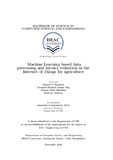| dc.description.abstract | The Internet of Things is best stated as a network of “things” that have the ability to generate
and share information between themselves and interact with the environment according to the
percepts from this environment. This network between these devices and humans generates a
massive amount of data that often leads to problems such as clogged networks, unhandled
data traffic and, thus, greater latency throughout the network. Machine learning, in the IoT
sector, helps to manage the data in a more seamless way. Classification plays a significant
role in predicting discrete actions based on the learnings from the extracted data of the
“things”. We have used agricultural data in order to predict controls that lead to maintaining
the optimal conditions for a select crop in our controlled environment. We have successfully
used a classification algorithm in our proposed model after analyzing the metrics of five
algorithms, namely Decision Tree, Logistic Regression, K-Nearest Neighbours, Gaussian
Naïve Bayes and Support Vector Classification to decide which one would be most suitable
for our scenario which is based on agriculture. Furthermore, using our proposed model,
we have successfully reduced latency throughout the scenario by bringing data processing
closer to the “things”. Our main purpose was to determine which classification algorithm
was suitable for implementing data processing in our scenario by using accuracy, precision,
recall, specificity and F1-score, as well as to reduce latency to make the IoT within our
scenario more effective and efficient using our proposed model. Experimental results showed
Decision Tree having the best performance with best scores of 100% in every metric and the
latency being decreased to approximately a range of 0.002 to 0.003 seconds.
Keywords: Internet of Things, IoT, Machine Learning, Classification, Decision Tree,
Latency, Accuracy, Sensors, Actuators. | en_US |

